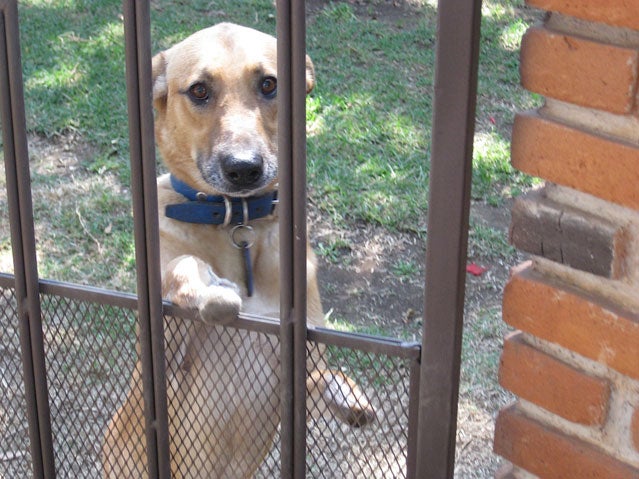The first rescue dog I met in Mexico was a timid Jack Russell terrier mix called Bobby. He was sitting in the back of a small white cargo van, wearing a plastic cone over his head and swallowed up in a pink comforter. Every time the van hit a speed bump, Bobby trembled and staggered. He tried to nuzzle my thigh but the cone kept getting in the way.
The Ultimate ���ϳԹ��� Companion
All you need to know about going wild with man’s best friend. Stray dog.
Stray dog. Laurel with Patricia Ruiz.
Laurel with Patricia Ruiz. Bobby.
Bobby. The view from Milagros Caninos.
The view from Milagros Caninos.We were headed to Milagros Caninos, the self-proclaimed first dog sanctuary in Latin America. Patricia Ruiz, the sanctuary’s founder, proprietor and chief evangelist, was driving. I was in the back with Bobby because Ruiz had company in the front seat—an intern from Germany and a Maltese with no right eye. As we bumped our way up into the hills above Xochimilco, Ruiz, a middle-age, petite blond in big, lightly-tinted sunglasses, kept asking if I was comfortable, and she began to tell me about her life’s work.
Years ago, before Milagros Caninos even existed, there was Bobby. He was Ruiz’s first rescue. She and her daughter had come across a small object nailed by its ears to a tree. At first they thought it was a doll but soon realized they were looking at a live dog. Unable to free him, Ruiz screamed and screamed until a passing driver stopped to help. They removed him from the tree, and Bobby has lived a healthy life in the years since—albeit with his ears partially amputated.
When we arrived at Milagros Caninos, I could see immediately why Ruiz called it a “sanctuary.” The place looked like a paradise. As Ruiz chatted with a young man who turned out to be Osvaldo Vital, the sanctuary’s full-time veterinarian, I examined the grounds. Beyond the edge of the driveway and through the trees was a view of the sweeping valley below. In the opposite direction was the sanctuary itself, gated and punctuated by a high, ivy-covered building. Men in dark red shirts and dusty red pants milled about. Including Dr. Osvaldo, Milagros Caninos has a staff of 10 that provides the dogs with 24-hour care.
Milagros Caninos (ineloquently-but-directly translated to “miracle canines”) has been open since 2006 and is currently home to 128 dogs who have all suffered at one point or another. It’s on the grounds of what used to be Ruiz’s family’s country home, located on the outskirts of Delegación Xochimilco, 15 miles south of the center of the city but further away in both practical and spiritual terms. To get there, I had to take two subways and ride the entire length of a light rail.
Xochimilco is famous for its floating gardens and massive canal system—the most visible remnant of an era when most of what is now Mexico City was underwater. More than 400,000 people live there, but in some ways, it barely feels like Mexico City at all. The taxis are the same color and the streets are still crowded, but the posters advertising DJ appearances and Stoli vodka you see glued to fences in my neighborhood aren’t there. Instead, you see posters for mariachi concerts and the upcoming rodeo. There are fewer tall buildings. There are more stray dogs.
DEPENDING ON WHOM YOU ask, between one and five million stray dogs live among the human population of about 22 million in greater Mexico City. Like they do just about everywhere else, dogs make popular pets here. Stroll through parks and you’ll see dozens of them either lined up obediently before trainers like fresh military recruits, splashing around off-leash in shallow fountains, or being carried around like babies in the arms of their owners. Then you’ll see those same owners suddenly changing directions in the middle of a sidewalk, yanking at their pet’s leashes in order to avoid an encounter with one of Mexico City’s many, many strays.
At first glance, the contrast between a nappy stray mutt and a sweater-wearing pug—between third- and first-world dog—looks like a convenient metaphor for Mexico City itself. According to (PDF), more than two-thirds of Mexico City residents live in poverty; air pollution, while improving, still sometimes keeps students inside at recess; and despite its relative isolation from narco-related violence, crime rates in Mexico City are high. At the same time, Mexico City is also a blossoming cultural and commercial center. European-style bicycle sharing has taken off and more new public transit initiatives are on the way. The art and music scenes are booming, and the historic center is undergoing a renaissance due to rehabilitation efforts funded by mega-billionaire telecommunications mogul Carlos Slim.
The differences are also evident in dog culture. On one hand, animal cruelty laws are insufficient and unenforced. Legally speaking, beating up a dog has not historically been much different from running through a stop sign. Pet abandonment is commonplace, and pet sterilization is still taboo. On the other hand, the city’s incoming head of government, Miguel Angel Mancera, has taken interest in animal issues, even pledging to build the first public hospital exclusively for the care of stray dogs.
AS SOON AS RUIZ led me through the gate into Milagros Caninos, we were greeted by dozens of yelping and howling and limping and ecstatic dogs. There were a few with three legs, a few more pulling wheelchairs. They jumped and played and ran wildly across the three-tiered lawn. Ruiz reached down to hug a shaggy old retriever mix.
“This one is named Almendro (Almond),” she said. “He is a dog who was addicted to drugs.”
Ruiz explained that when Almendro first arrived at Milagros Caninos, they had to keep him sequestered from other dogs for months while he sobered up and underwent treatment. During that time, he would hurt himself by flinging his body against walls.
“What drug was he addicted to?”
“Paint thinner.”
If he were returned to his old owners, Ruiz was sure Almendro would again be beaten and again become an addict. I got the sense that Ruiz considered Almendro and the other dogs at Milagros Caninos to be her own; they were all her pets. I had been under the impression that the dogs only lived in the sanctuary for a short period before finding permanent homes elsewhere—but adoption from Milagros Caninos is rare.
As Ruiz said, “Nobody wants to adopt a paraplegic dog, a blind dog, a dog without eyes, a dog with cancer.”
Soon after Almendro, I met Laurel, who had his jaw, tongue, and teeth tied to the bumper of a car and yanked almost completely off. Under a shaggy coat that covered his eyes, I could barely see that Laurel had no lower jaw whatsoever. I also met Apio (Celery), who had his penis cut off in such a way that, before undergoing surgery, he was unable to urinate. Ruiz approached Apio and ruffled the scruff of his neck and said, with complete sincerity, “Now you can make pee pee. Yes you can, yes you can.”
Milagros Caninos is a better home than most adoptive parents could provide. Here there is full-time attention, 15,000 square meters of open space, and the companionship of other dogs. But staffing a place like Milagros Caninos is expensive—so are the food and medical supplies needed to care for 128 dogs. Ruiz pays for nearly everything with what she solemnly and repeatedly calls “personal resources.” Those resources, though, are nearly exhausted. Milagros Caninos is unable to accept any new dogs. But even if they could, it would not be nearly enough.
BETO CASTILLO HEADS THE non-profit group El Muro (The Wall). On Ruiz’s recommendation, I met Castillo backstage of a show called “ANIMAL … ES” that his group puts on three times a week in a small Mexico City playhouse. Castillo and an actress named Sylvia Pasquel star in the show, which consists of skits, monologues, and short video interludes, along with a different celebrity guest in every performance. In a shiny red shirt and skinny black tie, Ruiz came off a bit like the entertainment director of a cruise ship—and he happily hammed it up for the audience from the start of the show. But when Castillo spoke about animals and violence in Mexico, he sounded like an on-message politician. He admires Ruiz more than anybody in Mexico for the work she does at Milagros Caninos, but he believes that shelters and sanctuaries are inherently flawed because they address the symptoms of Mexico’s stray dog problem, not the disease.
“We think those efforts are admirable, but they’re not going to change the situation because they don’t reach people,” Castillo said. “They’re taking care of the dog, but they’re not reaching the person. The person who abandons, the person who abuses, the person who is indifferent.”
Due to sheer logistical difficulty and the constant battles to secure funding, the work shelters and sanctuaries do is inherently inward-looking, when what’s needed is to look outward.
“We can’t find homes for five million dogs,” Castillo said, “We’re not going to be able to give them away in adoptions. But we can try to sterilize the majority, or at least a percentage, and at least stop them from reproducing while they keep living in the streets.”
Still, one of the monologues in “ANIMAL … ES” dealt with the story of a dog who lives at Milagros Caninos.
RUIZ HAD MENTIONED PAY de Limón (Lime Pie) on the van ride up to the sanctuary, but I had no idea what she was talking about—I didn’t yet know that nearly all of her dogs are named after foods. We climbed up to the highest tier of the tortured dog area of Milagros Caninos and over to a fenced-in section where a single, light-brown dog was playing with one of the red-shirted staff members, jumping up and down on his hind legs with incredible balance. I asked why Pay de Limón was by himself. He is so famous, Ruiz said, that people come to Milagros Caninos just to see him.
Pay was rescued from a trash heap in Fresnillo, Zacatecas, with no front paws. Apparently before moving on to torturing humans—cutting off fingers, one by one, and then the entire hand—a criminal organization had practiced on Pay. The amputations had been extremely clean, indicating the work of professionals, vets said. After he was found, Pay had been sent covertly to Milagros Caninos, where at first he was kept, hidden from the public. Eventually, with the help of a lab in Denver called OrthoPets, Pay was fitted with prosthetic front paws, and he re-learned how to run around normally.
But even with his prosthetics off, as they were that day, Pay de Limon seemed as happy as any four-legged dog I’d ever seen. His tail wagged, and his tongue drooped from his mouth. It was hard to imagine how a dog going through an ordeal like that and still remain so pleasantly dog-like. I asked Ruiz for more detail.
“Was it a narco group?”
“A very famous narco group.”
“Can you say the name?”
Her voice hushed.
“The Zetas,” she said. “This [story] isn’t coming out in Mexico right?”
One talking point I’ve heard repeatedly from animal rights activists in Mexico is that serial killers frequently begin with the torture and murder of animals. This notion is the basis for much of the work that Castillo’s group El Muro sets out to do and has even greater prescience because of the ongoing and omnipresent drug violence in the country. In 2009, an alleged Zetas leader named Baltazar Saucedo Estrada was arrested for orchestrating an attack that killed 53 people at a casino. His nickname? “Mataperros,” or “Dog Killer.” There have also been reports that cartels train and even desensitize recruits by having them on dogs.
When we entered Pay de Limón’s pen, Ruiz took his stumps in her hands. (Pay’s prosthetics had just been adjusted in Denver and were waiting for him at a nearby veterinary hospital.) “I’m your mommy,” she kept saying, “I’m your mommy.”
A NATION OF MOMS like Ruiz isn’t enough to solve Mexico’s stray dog problem. It is the result of generations of human negligence and will require generations of broad societal awareness to resolve. But progress is being made. Sterilization education in Mexico City is slowly beginning to take hold. Activists believe that what happens first in Mexico City will eventually spread to the rest of the country. Progressive ideas generally radiate outward from the capital, catching on in big cities like Monterrey and Guadalajara and then in rural areas like Oaxaca. Also in Mexico City, legislation was recently signed that, for the first time, recognizes animal cruelty as a crime punishable under the penal code—something more severe than a traffic violation. But in a country that has than it has children under nine years old, educating pet owners is only a start. There are still all the animals on the street, living terribly but still reproducing, unencumbered by human society.
While people like Castillo and Ruiz argue loudly for the sterilization of stray dogs, local and state governments generally opt to either ignore strays or to simply put them down. Legally, governments that put down stray dogs are required to do so in a humane fashion. However, giving street dogs a dignified death is hardly a priority for governments dealing with poverty, corruption, and a drug war. Barbiturate injections (the preferred humane method) are expensive. Other methods, like electrocution, are not. In some pounds (known as centros antirrábicos, or anti-rabies centers, in Mexico), the dogs are simply wetted and then connected to a car battery. In others, men allegedly lock them into cages and beat them to death with baseball bats.
According to Castillo, society pays the price when people are forced to make a living by killing so many dogs with such brutal methods. He painted a dramatic picture of a broke man with an unhappy home life taking his frustrations out on dogs every day at the pound. That violence then becomes routine, and animals become objects. But the effect of such policies is also broader, and hints at the tensions between first-world Mexico and third-world Mexico. Take this, from a 2006 editorial in the newspaper , which is published by the National Autonomous University of Mexico (UNAM):
“Even though our government officials like to tell us that we are part of the first world, our public health authorities continue to employ cruel methods to ‘control’ the overpopulation of dogs and cats, which is a symptom mainly of civic irresponsibility, of insufficient legislation in regards to animal care, and of people’s willingness to abandon pets or let them reproduce at will then leave the resulting puppies, unwanted, in the street.”
Earlier this year, the municipal government of Tlalnepantla, a municipality in Estado Mexico (adjacent to Mexico City), which puts down about 900 stray dogs a month, . This is where Castillo believes sterilization should come in. Sterilizing a dog is more expensive than electrocution and other inhumane methods but still cheaper than a barbiturate cocktail. Better to let them go on living bad lives on the streets than to force dogs to suffer cruel deaths, the thinking goes. Through sterilization, Mexico’s stray dog population can shrink in a slow and humane way. No solution is perfect, though, and while dogs with responsible and educated owners can be tended to relatively easily, who exactly is going to drive around picking up all the stray dogs, millions of them, and take them in to get spayed and neutered?
“HIS NAME IS TLACOYO,” Ruiz said of a dog who was off by himself, staggering in the shade of a tree. “He has a neurological disorder. He walks in circles. He does it all day.”
“Does he play much with other dogs?”
“Also, he’s blind.”
We finished the tour in the high-ceilinged room where Milagros Caninos serves tacos and sells T-shirts to the hundreds of people who come visit the sanctuary on the one Sunday a month it is made open to the public. Some Sundays the sanctuary gets over 600 people and is forced to turn them away at the base of the driveway. Ruiz asked me whether I ever owned any dogs, and it turns out we both grew up with Airedale Terriers. I wondered what was it about dogs that made them seem so obviously worth endeavors like this one, worth giving over a country estate and a fortune and a lifetime of energy to—even secure in the knowledge that you could only directly help some hundreds among the needy millions.
“Everything is worth it,” Ruiz said. “You suffer a lot, but it’s worth it. There are some days that are really difficult, but in the end when you see that you’ve tried to help a dog or a lot of dogs, it’s worth having lived that day, even with all the sad and hard parts.”
Ruiz and I loaded into the van with the one-eyed Maltese, with Bobby, and this time with Pay de Limon, who was on his way to the veterinary hospital to try out his new prosthetic paws. We made our way down through the hills, past the canals, which Hernan Cortes had once compared to those of Venice, and into bustling Xochimilco. At a stoplight, Ruiz looked out the window and saw a stray dog with a sagging belly standing alone on the sidewalk.
“She has puppies in there.”
lives in Mexico City. His work has appeared in Slate, Deadspin, The Daily Beast, and The Best American Sports Writing. He founded the baseball blog Pitchers & Poets and is a founder of .


